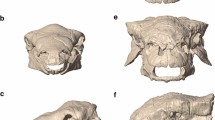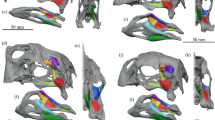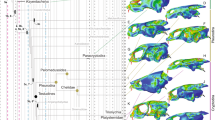Abstract
Prey-capture strategies in carnivorous dinosaurs have been inferred from the biomechanical features of their tooth structure, the estimated bite force produced, and their diet1,2,3. Rayfield et al.4 have used finite-element analysis (FEA) to investigate such structure–function relationships in Allosaurus fragilis, and have found that the skull was designed to bear more stress than could be generated by simple biting. They conclude that this large theropod dinosaur delivered a chop-and-slash 'hatchet' blow to its prey, which it approached with its mouth wide open before driving its upper tooth row downwards. We argue that this mode of predation is unlikely, and that the FEA results, which relate to an 'overengineered' skull, are better explained by the biomechanical demands of prey capture. Understanding the mechanics of predation is important to our knowledge of the feeding habits of carnivorous dinosaurs and for accurate reconstruction their lifestyles.
This is a preview of subscription content, access via your institution
Access options
Subscribe to this journal
Receive 51 print issues and online access
$199.00 per year
only $3.90 per issue
Buy this article
- Purchase on Springer Link
- Instant access to full article PDF
Prices may be subject to local taxes which are calculated during checkout

Similar content being viewed by others
References
Farlow, J. O. Am. Mid. Nat. 95, 186–191 (1976).
Farlow, J. O., Brinkman, D. L., Abler, W. L. & Currie, P. J. Mod. Geol. 16, 161–198 (1991).
Erickson, G. M. et al. Nature 382, 706–707 (1996).
Rayfield, E. J. et al. Nature 409, 1033–1037 (2001).
Frazzetta, T. H. J. Morphol. 111, 287–320 (1962).
Schwenk, K. in Feeding in Tetrapod Vertebrates: Form, Function, Phylogeny (ed. Schwenk, K.) 175–291 (Academic, San Diego, 2000).
Madsen, J. H. J. Utah Geol. Min. Surv. Bull. 109, 1–163 (1976).
Ahlberg, P. E., Clack, J. A. & Luks̆evic̆s, E . Nature 381, 61–64 (1996).
Frazzetta, T. H. in Advances in Herpetology and Evolutionary Biology (eds Rodin, A. G. J. & Miyata, K.) 222–244 (Harvard Univ. Press, Cambridge, Massachusetts, 1983).
Frazzetta, T. H. in Evolutionary Biology (eds Hecht, M. K., Wallace, B. & Prance, G. T.) 419–461 (Plenum, New York, 1986).
Author information
Authors and Affiliations
Corresponding author
Rights and permissions
About this article
Cite this article
Frazzetta, T., Kardong, K. Prey attack by a large theropod dinosaur. Nature 416, 387–388 (2002). https://doi.org/10.1038/416387a
Issue Date:
DOI: https://doi.org/10.1038/416387a
Comments
By submitting a comment you agree to abide by our Terms and Community Guidelines. If you find something abusive or that does not comply with our terms or guidelines please flag it as inappropriate.



